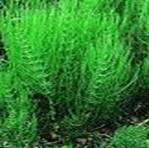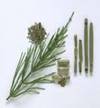Scientific Classification:
|
Other Common Names:
The other common names for the herb horsetail are Bottlebrush, Mare's Tail, Scouring Rush, Shave Grass, Pewterwort, Equisetum, Queue de Cheval, Dutch Rushes and Giant Horsetail.
History

Description



Range
Field horsetail is a native species that can be found throughout the world. This species is most common in the temperate zones of North America, Europe and Russia.
Habitat
Field horsetail thrives in many habitats and is just at home in wet, poorly drained areas of fields and grasslands; wet meadows; streams and other sites with high water tables as in well drained sites in farm fields, orchards and nursery crops, and in sites with sandy or gravelly soil such as along roadsides, railroad tracks and beaches. In general, horsetail appears most commonly in acidic and wet soil conditions.
Cultivation
The main mode of reproduction of field horsetail is asexual; conditions for the production of gametophytes from spores are limited and relatively rare .Field horsetail spreads from extensive rhizomes. Even short segments of broken rhizomes will sprout.Overwintering buds develop at the nodes of the rhizomes. The spores of field horsetail are equipped with elaters, which are long appendages that expand and contract with changes in humidity. Elaters function to dig the spore into the soil surface and to tangle spores together, thereby creating a larger propagule and increasing the probability that prothalli will be close enough to ensure fertilization. Elaters may also aid in wind dissemination. Spores released by the strobiliferous stems are dispersed by wind or water. The spores are thin-walled, short-lived, and quickly germinate under moist conditions. The spores germinate to form prothalli: tiny plants only a few cell layers thick that are usually either male or female, producing only antheridia or archegonia, respectively. Swimming sperm are released by the antheridia and require water for transport to the egg-containing archegonia. After fertilization takes place, the sporophytic generation (the identifiable large plant) develops in situ, growing out of the prothallus.
Flowering Season
Like ferns, field horsetail does not produce flowers or seeds.
Pests and Diseases
Horsetail is affected by diseases like stemcanker, crickets and other bark eating caterpillar like celostrena scabrator, rhinoceros beetle and arbela tetraonis. Infection by the root fungus Trichosporium vesiculosum is among the more serious diseases affecting Casuarinas.
Parts Used
 |
The aerial parts of the plant horsetail are generally used for its medicinal and commercial applications. |
Medicinal Applications


- Horsetails clumps were normally used as scouring pads to facilitate the cleaning of iron cookware and hard pewter dishes.
- Some herbalist and folk healers suggest that athletes suffering from problems such as sprains and dislocated joints, and pulled hamstrings or torn ligament injuries could benefit from supplements of the horsetail herb in the diet.
- The texture, strength and tone of hard tissues such as the hair, the nails and the skin is also greatly improved by horsetail, at the same time the herb is very good at greatly strengthening the bones and the teeth of people.
- Problems such as minor edema can be treated by drinking an herbal tea made from the horsetail.
- Topical injuries of a minor nature can also be treated using the horsetail, a minor cut or bruise can be treated using some herbal horsetail powder from a capsule or a crushed tablet.
- Urinary problems of all types can also be treated using the horsetail herb, which is a reliable diuretic.
- Horsetail being a diuretic and an astringent is used in the treatment of all kinds of kidney and bladder conditions.
- It acts as a rapid remedy for the disorder called dropsy.
- Horsetail is used in healing of cuts and bruises as well as being able to stop the bleeding of wounds.
- The internal tissue damage in connective tissue is also repaired and corrected by the horsetail herbal remedies, which speeds up the rate of tissue repair, thereby promoting the strength and elasticity in the newly formed tissues.
- Symptoms caused by rheumatic and arthritic problems and various chest ailments are also treated by horsetail.
- Children affected by frequent urges to urinate, by bed wetting behaviours and incontinence for a long time can be treated using the horsetail as the astringent properties of the herb make it a very useful remedy to check such problems.
- The horsetail is also effective in treating such disorders which affect the functioning of the digestive tract; it is capable of healing inflammation and ulcers in the stomach.
- Horsetail based mouthwash and gargle can also be used for the treatment of problems such as mouth ulcers, it can be used to stanch bleeding gums and in the treatment of sore throats and other oral problems.
- It is also used in the manufacture of some kind of dye.
- Tubers of field horsetail are rich in starch and are eaten by wildlife. Native Americans consumed young fertile shoots.
Commercial Applications
- Horehound is a serviceable remedy against Cankerworm in trees, and it is stated that if it be put into new milk and set in a place pestered with flies, it will speedily kill them all.
- The plant is easily grown and has been long been cultivated in the corners of country gardens for the making of tea and candy for use in coughs and colds.
- The leaves are used in the manufacture of horehound teas and wines.
Folklore and Myths
The genus name, Equisetum, translates to "horse-bristle" or tail, describing the appearance of the sterile stems. Deposits of silica cover the vegetative stems and branches of field horsetail. For this reason, the plant has been used to scour pots, pans, and articles containing silver (hence the common name 'scouring rush').Field horsetail may accumulate more gold than any other plant. Up to 4 1/2 ounces of gold per ton of fresh plant material has been recovered. Mining engineers consider field horsetail an indicator species of gold, but not a viable commercial source.

